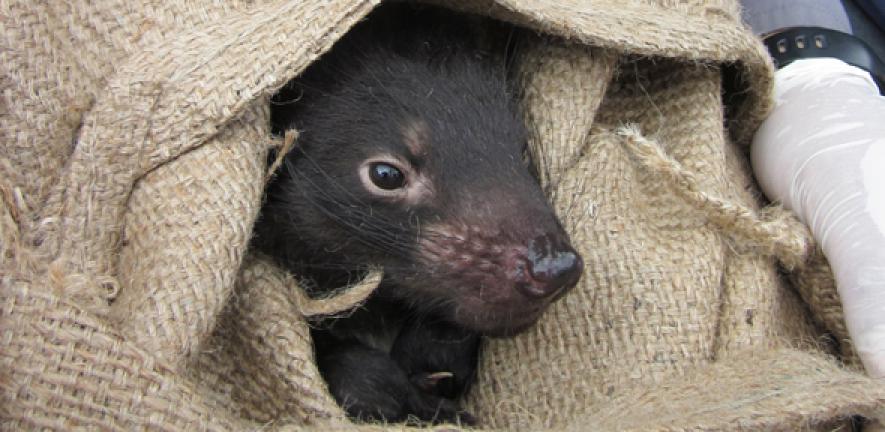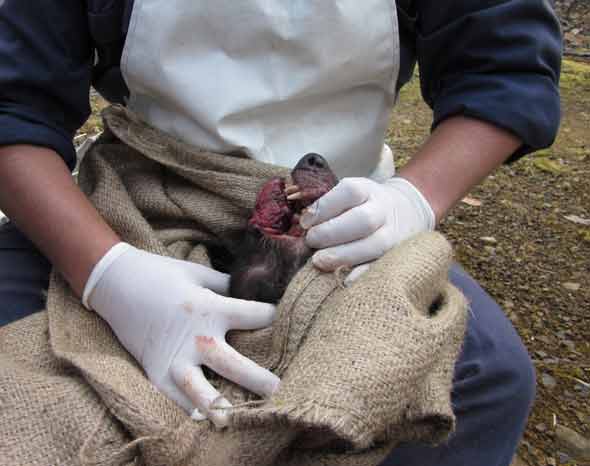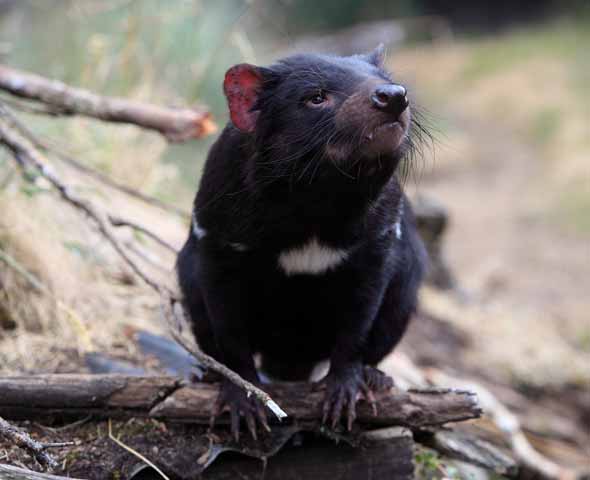
The Cambridge Animal Alphabet series celebrates Cambridge's connections with animals through literature, art, science and society. Here, T is for Tasmanian Devil and the researchers studying the transmissable cancer that threatens these marsupials with extinction.
The Cambridge Animal Alphabet series celebrates Cambridge's connections with animals through literature, art, science and society. Here, T is for Tasmanian Devil and the researchers studying the transmissable cancer that threatens these marsupials with extinction.
We are motivated by the goal that our research will help to protect this unique and iconic marsupial from extinction
Elizabeth Murchison
Scroll to the end of the article to listen to the podcast.
In 1996 a wildlife photographer working in a remote part of Tasmania noticed a ‘Tassie devil’ (the affectionate name for the Tasmanian devil) with a tumour on its face. He assumed that the animal’s facial disfigurement was a one-off – but within a year he spotted another devil with a similar problem. He notified the authorities and, as increasing numbers of affected devils were seen, it was established that the animals were suffering from a wave of devastating facial tumours.
Ten years after the first tumour was spotted, scientists revealed that the lesions weren’t ordinary tumours. They were caused by a transmissible cancer – an extremely rare type of disease, in which living cancer cells are physically transmitted between animals. Only three transmissible cancers are known in nature, and these affect dogs, clams and Tasmanian devils respectively. In the case of devils, the cancer cells are thought to be transmitted by biting.
Once they have acquired the cancer, devils usually live just a matter of months. No treatment exists. As the number of sightings of afflicted animals continued to escalate, with the disease moving across the island from east to west, it became clear that the Tasmanian devil was threatened with extinction.
Dr Elizabeth Murchison, a specialist in comparative oncology and genetics at the University of Cambridge’s Department of Veterinary Medicine, was brought up in Tasmania. The presence of Tasmanian devils – which are the emblem of the Tasmanian state – was part of her rural childhood. Devils are scavengers and, by disposing of dead animals, they provide a useful service as the ‘garbage bins of the bush’.
Murchison studied genetics and biochemistry at the University of Melbourne, and then studied for her PhD in molecular biology at Cold Spring Harbor Laboratory, New York. Her interest in solving the puzzle of the tumours began in 2006 when she came across a roadkill devil with a tumour in a wild area of Tasmania. This confronting finding triggered her desire to understand this strange disease.

Her specialism is cancer genetics; her research focuses on developing an understanding of the evolution of the DNA of transmissible cancer by tracing it backwards in time to track the steps by which a normal cell mutates to become a cancerous one.
In 2012, while working at the Sanger Institute, near Cambridge, Murchison led a collaborative group of scientists using new DNA sequencing technologies to unlock the Tasmanian devil genome, as well as the genome of the devils’ transmissible cancer. This research led to the discovery that the Tasmanian devil cancer probably emerged relatively recently in a single female Tasmanian devil. The cells derived from this cancer have continued to survive by “metastasising” through the Tasmanian devil population.
More recently, Murchison has concentrated on understanding the genetic differences between tumours occurring in different Tasmanian devils. Although tumours in all Tasmanian devils are a “clone”, derived from the same original animal, the cancer lineage has diverged and acquired new mutations during its spread through the devil population.
This work requires close collaboration with many scientists, especially those back in her native Tasmania. She says: “I wake up to emails from the other side of the world, updating me on the progress of field work back in Tasmania. We skype regularly because working closely together as an interdisciplinary team is the best way to try to understand this disease and help the devils as soon as possible.”
In addition to working on the Tasmanian devil, Murchison’s group studies canine transmissible venereal tumour (CTVT). CTVT is a sexually transmitted genital cancer, spread by the transfer of living cancer cells between dogs. In contrast to the devil cancer, which emerged relatively recently, CTVT probably emerged thousands of years ago. The disease has now spread widely and affects dogs around the world. Murchison’s group has recently sequenced the genome of CTVT, and this work has shed light on the evolution of a unique cancer.
One of the most disquieting aspects of transmissible cancers is the fact that they are, effectively, parasites. Once the devil cancer cells are introduced to a new host by means of a bite, they go undetected by the devil’s immune system and thus flourish, eventually killing the animal. By sequencing samples of DNA taken from the devil cancer from 2003 onwards, Murchison is trying to understand how this cancer evolved and changed with time. Her research makes a valuable contribution to the potential development of a vaccine or other therapy to protect devils against the disease.

Over the past decade, the Tasmanian authorities have worked hard to safeguard the future of the Tasmanian devil. An ‘insurance’ population of healthy devils has been spread among Australian parks and zoos. Most recently, a colony of unaffected devils has been established on Maria Island, a national park off the coast of eastern Tasmania.
“Research into this devastating disease in Tasmanian devils is starting to illuminate the underlying processes that caused this unusual disease and promoted its transmission. We hope that our research may also help us to understand basic processes that underlie cancer evolution more generally, including in humans. But, of course, we are motivated by the goal that our research will help to protect this unique and iconic marsupial from extinction,” said Murchison.
Next in the Cambridge Animal Alphabet: U is for an animal used in heraldry since the 15th century and in recipes for anti-poison since the 1700s.
Have you missed the series so far? Catch up on Medium here.
Inset images: Tasmanian devil with facial tumours (Elizabeth Murchison); Video clips courtesy of the Save the Tasmanian Devil Program , DPIPWE; Tasmanian devil (Joe Le Nevez).

The text in this work is licensed under a Creative Commons Attribution 4.0 International License. For image use please see separate credits above.




